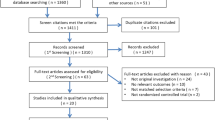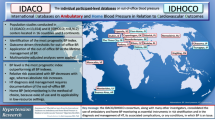Abstract
The available, albeit rare, evidence indicates the superiority of home- over office blood pressure monitoring (HBPM vs OBP) to predict cardiovascular (CV) outcomes. We performed a systematic review to update the efficacy of HBPM vs OBP as predictors of all-cause mortality, CV death, and target organ damage. Two reviewers independently performed the literature search in various databases. A meta-analysis with a fixed-effect model was conducted, and the heterogeneity and inconsistency indices were assessed. The search identified 291 articles, of which 10 were eligible for inclusion in the study, and five articles published in 2012 were included in the meta-analysis. A previous meta-analysis showed the superiority of HBPM over OBP to predict all-cause mortality, CV mortality, and CV events. The meta-analysis of articles published in 2012 identified that HBPM was also a better predictor of proteinuria than OBP. In conclusion, the results of our systematic review and meta-analysis confirm that HBPM is a better predictor of CV outcomes and target organ damage than OBP.


Similar content being viewed by others

References
Papers of particular interest, published recently, have been highlighted as: • Of importance •• Of major importance
Lewington S, Clarke R, Qizilbash N, Peto R, Collins R. Age-specific relevance of usual blood pressure to vascular mortality: a meta-analysis of individual data for one million adults in 61 prospective studies. Lancet. 2002;360:1903–13.
Shimbo D, Pickering TG, Spruill TM, Abraham D, Schwartz JE, Gerin W. Relative utility of home, ambulatory, and office blood pressures in the prediction of end-organ damage. Am J Hypertens. 2007;20:476–82.
Stergiou GS, Argyraki KK, Moyssakis I, Mastorantonakis SE, Achimastos AD, Karamanos VG, et al. Home blood pressure is as reliable as ambulatory blood pressure in predicting target-organ damage in hypertension. Am J Hypertens. 2007;20:616–21.
• Bliziotis IA, Destounis A, Stergiou GS. Home vs ambulatory and office blood pressure in predicting target organ damage in hypertension: a systematic review and meta-analysis. J Hypertens. 2012;30:1289–99. This systematic review addressed HBPM vs OBP as predictors of LVMI and several parameters of target organ damage.
Sheikh S, Sinha AD, Agarwal R. Home blood pressure monitoring: how good a predictor of long-term risk? Curr Hypertens Rep. 2011;13:192–9.
Ward AM, Takahashi Pickering TG, Miller NH, Ogedegbe G, et al. Call to action on use and reimbursement for home blood pressure monitoring: a joint scientific statement from the American Heart Association, American Society of Hypertension, and Preventive Cardiovascular Nurses Association. Hypertension. 2008;52:10–29.
Chobanian AV, Bakris GL, Black HR, et al. The Seventh Report of the Joint National Committee on prevention, detection, evaluation, and treatment of high blood pressure: the JNC 7 report. JAMA. 2003;289:2560–72.
•• Ward AM, Takahashi O, Stevens R, Heneghan C. Home measurement of blood pressure and cardiovascular disease: systematic review and meta-analysis of prospective studies. J Hypertens. 2012;30:449–56. This systematic review verified HBPM and OBP as predictors of all-cause and cardiovascular mortality, using an appropriate methodology.
Fuchs SC, Ferreira-da-Silva AL, Moreira LB, Neyeloff JL, Fuchs FC, Gus M, et al. Efficacy of isolated home blood pressure monitoring for blood pressure control: randomized controlled trial with ambulatory blood pressure monitoring – MONITOR study. J Hypertens. 2012;30:75–80.
Picon RV, Fuchs FD, Moreira LB, Fuchs SC. Prevalence of hypertension among elderly persons in urban Brazil: a systematic review with meta-analysis. Am J Hypertens. 2013;26:541–8.
Picon RV, Fuchs FD, Moreira LB, Riegel G, Fuchs SC. Trends in prevalence of hypertension in Brazil: a systematic review with meta-analysis. PLoS One. 2012;7:e48255.
Von Elm E, Altman DG, Egger M, Pocock SJ, Gotzsche PC, Vandenbroucke JP. The Strengthening the Reporting of Observational Studies in Epidemiology (STROBE) statement: guidelines for reporting observational studies. Ann Intern Med. 2007;147:573–7.
Freemantle N, Mason JM, Haines A, Eccles MP. CONSORT: an important step toward evidence-based health care. Consolidated Standards of Reporting Trials. Ann Intern Med. 1997;126:81–3.
Moher D, Liberati A, Tetzlaff J, Altman DG. PRISMA Group. Preferred reporting items for systematic reviews and meta-analyses: the PRISMA Statement. Open Med. 2009;3:e123–30.
Neyeloff JL, Fuchs SC, Moreira LB. Meta-analyses and Forest plots using a Microsoft excel spreadsheet: step-by-step guide focusing on descriptive data analysis. BMC Res Notes. 2012;5:52.
Yano Y, Hoshide S, Shimizu M, Eguchi K, Ishikawa J, et al. Association of home and ambulatory blood pressure changes with changes in cardiovascular biomarkers during antihypertensive treatment. Am J Hypertens. 2012;25:306–12.
Ishikawa J, Hoshide S, Eguchi K, Ishikawa S, Shimada K. Nighttime home blood pressure and the risk of hypertensive target organ damage. Hypertension. 2012;60:921–8.
•• Hara A, Tanaka K, Ohkubo T, Kondo T, Kikuya M, et al. Ambulatory versus home versus clinic blood pressure and the association with subclinical cerebrovascular diseases: The Ohasama Study. Hypertension. 2012;59:22–8. This article provided evidence of the independent prognostic value of HBPM vs OBP in assessing cerebrovascular disease, among 1007 subjects of the general population of Ohasama, Japan.
Higgins JP, Thompson SG, Deeks JJ, Altman DG. Measuring inconsistency in meta-analyses. BMJ. 2003;327:557–60.
Compliance with Ethics Guidelines
ᅟ
Conflict of Interest
Sandra C. Fuchs declares that she has no conflict of interest. Renato G. B. de Mello is employed by the Brazilian National Counsel of Technological and Scientific Development – CNPQ, as the Medical Manager of the PREVER Trial.
Felipe C. Fuchs declares that he has no conflict of interest.
Human and Animal Rights and Informed Consent
This article does not contain any studies with human or animal subjects performed by any of the authors.
Author information
Authors and Affiliations
Corresponding author
Additional information
This article is part of the Topical Collection on Hypertension
Rights and permissions
About this article
Cite this article
Fuchs, S.C., de Mello, R.G.B. & Fuchs, F.C. Home Blood Pressure Monitoring Is Better Predictor of Cardiovascular Disease and Target Organ Damage than Office Blood Pressure: A Systematic Review and Meta-Analysis. Curr Cardiol Rep 15, 413 (2013). https://doi.org/10.1007/s11886-013-0413-z
Published:
DOI: https://doi.org/10.1007/s11886-013-0413-z



